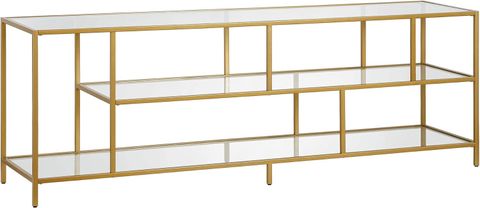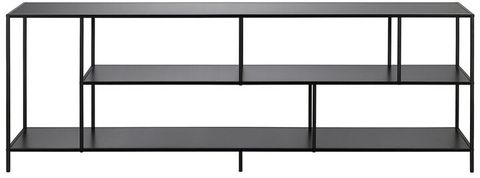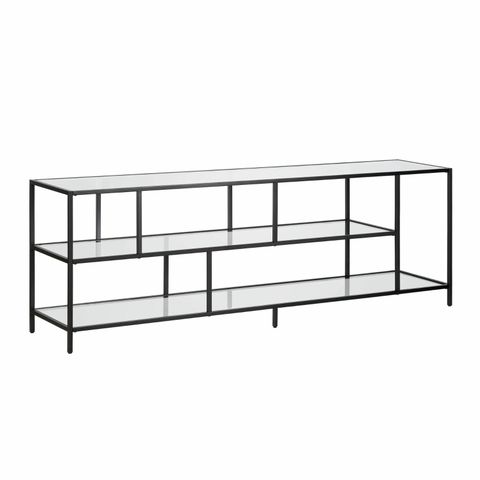Picture this: You’ve just bought that dream 65-inch television, and now you’re staring at the blank space where it should sit. It’s not just about finding a place for your screen—it’s about creating the right environment for your viewing experience. The stand you choose can make or break how your large-screen display looks and functions in your living room.
When it comes to large-screen televisions, the right stand isn’t just about holding your display up—it’s about enhancing your entire viewing experience. Whether you’re dealing with a 55-inch model or a massive 85-inch beast, selecting the appropriate stand requires consideration of more than just size. It’s about aesthetics, functionality, and practicality all rolled into one. This isn’t just another piece of furniture; it’s a statement about how you want to experience media in your home. The stand becomes part of your room’s design language and plays a crucial role in how your TV integrates with the rest of your space.
Understanding Your TV’s Physical Requirements
Before diving into stand options, you must first know your television’s exact specifications. Start with measuring the width, height, and depth of your display. Many people overlook the importance of checking the VESA mounting pattern, which determines what type of wall mount or stand will work with your TV. A standard VESA pattern might be 200x200mm or 400x400mm, and these measurements matter because they affect the stand’s compatibility. Don’t forget to check the weight capacity too. A 75-inch TV typically weighs between 60 and 80 pounds, while larger models can exceed 100 pounds. If you’re planning to mount your TV, ensure the stand can support that weight. For example, if you have a 70-inch Samsung QLED that weighs 75 pounds, you’ll want a stand rated for at least 100 pounds to account for safety margins. Also, consider the aspect ratio and whether your TV has a curved screen, which may require special mounting considerations. Some stands are specifically designed for curved displays, offering better support and preventing warping over time.
Assessing Your Room Layout and Space Constraints
The physical space where your TV will live plays a huge role in determining what kind of stand you need. Measure the area carefully, including any existing furniture like entertainment centers, bookcases, or coffee tables. You want to ensure there’s adequate clearance around your display for ventilation and easy access. Think about where you’ll be sitting and how far away you’ll be from the screen. A 65-inch TV needs roughly 9 feet of viewing distance for optimal comfort. Consider the height of your seating area as well. If you have a low couch or recliner, you might need a higher stand to keep the screen at eye level. For instance, if your seating is 24 inches off the ground and your TV is 36 inches tall, you’ll want to position the center of your screen at about 42 inches high for comfortable viewing. Also, think about what’s around the TV. Do you have a wall-mounted shelf nearby? Is there a fireplace mantel? These elements can influence both the style and placement of your stand. Sometimes, a corner installation works perfectly, especially in smaller spaces where maximizing floor area matters.
Considering Aesthetics and Design Integration
The visual appeal of your stand should complement rather than compete with your room’s overall design. Modern minimalist homes often favor sleek, simple stands made from materials like brushed aluminum or clean wood finishes. On the other hand, traditional or rustic settings might call for more ornate wooden stands with carved details. The color of your stand should either match or contrast appropriately with your existing decor. Dark woods like walnut or espresso work well with contemporary settings, while lighter woods such as oak or maple can brighten up a room. Take into account the finish of your TV too—some stands are designed to hide cables, others expose them for a more industrial look. If you’re using a stand with built-in cable management, it can significantly reduce clutter and make your setup look more professional. For example, a matte black stand with hidden wire channels might be perfect for a modern living room with neutral tones and clean lines. But if your space features bold patterns and rich textures, perhaps a wooden stand with visible hardware could add character instead.
Evaluating Storage and Cable Management Needs
Large-screen TVs often come with multiple connection ports and accessories that need somewhere to go. A good stand should provide storage solutions for devices like streaming boxes, soundbars, gaming consoles, and remote controls. Think about how many devices you plan to keep near your TV and what kind of organization you prefer. Some stands feature drawers, shelves, or compartments that can hold everything from HDMI cables to game controllers. Cable management is equally important. Look for stands with built-in routing systems that keep cords neat and out of sight. This prevents tangling and makes maintenance easier. If you’re planning to add accessories like a soundbar or gaming system later, make sure there’s room for expansion. For example, a stand with three drawer compartments plus a shelf underneath could accommodate a streaming device, gaming console, and soundbar while keeping everything organized. You might also want to consider stands with adjustable shelving that allows you to customize storage based on your changing needs. Some people find that having a dedicated spot for their remote control prevents the constant search for it during movie nights.
Safety and Stability Factors to Consider
Safety should never be overlooked when choosing a TV stand, especially with larger screens. The stand must be sturdy enough to handle not just the weight of your TV but also any accidental bumps or vibrations. Look for stands made from solid materials like steel or heavy-duty wood rather than flimsy particle board or thin metals. Check the stability rating of the stand, particularly if you have children or pets around. A wide base provides better balance, and some stands even include anti-tip brackets for added security. Weight distribution is also crucial. A stand that’s too narrow compared to your TV’s width can cause tipping issues. For instance, a 75-inch TV should ideally have a stand that’s at least 60% of the screen’s width to maintain stability. Also consider the placement of the stand itself. Ensure it’s placed on a flat surface and not on an unstable surface like a wobbly table or uneven floor. If your room has a slight slope or your floor isn’t perfectly level, you might need a stand with adjustable feet. Some stands offer this feature to help level the display even on slightly uneven surfaces. Always follow manufacturer recommendations for installation and placement to avoid accidents.
Budget Considerations and Value for Money
TV stands range widely in price, from affordable options under $100 to premium designs that cost several hundred dollars. Set a realistic budget before shopping, but remember that quality often pays off in the long run. A cheap stand might save money upfront, but if it breaks or doesn’t properly support your TV, you’ll end up spending more later. Consider what features matter most to you—do you prioritize storage, aesthetics, or durability? A mid-range stand that offers good build quality and essential features might be more cost-effective than an expensive model with unnecessary extras. For example, a $150 stand with solid construction and basic storage might be worth more than a $300 stand that’s overly decorated but poorly built. Compare similar models across different retailers to get the best deal. Some companies offer warranties or return policies that can provide peace of mind. Don’t forget to factor in delivery costs and assembly requirements. Sometimes buying a slightly more expensive stand that’s easier to install saves time and effort. Reading reviews from users who have similar TV sizes and setups can give you a better sense of whether a particular stand offers good value for money. Ultimately, the right stand is one that fits both your wallet and your needs, not necessarily the most expensive option.
Choosing the right TV stand for your large-screen display involves careful consideration of multiple factors—from physical dimensions and room layout to aesthetics and safety. It’s not just about finding something that holds your TV upright; it’s about creating a cohesive setup that enhances your viewing experience and fits seamlessly into your lifestyle. The investment you make in the right stand pays dividends in terms of both function and appearance. Whether you’re upgrading from a small screen or moving to a massive display, taking the time to evaluate your needs thoroughly will result in a decision that brings satisfaction for years to come. Remember, the best stand is one that balances your practical requirements with your personal style, ensuring that your television becomes not just a screen but a centerpiece of your entertainment space.













